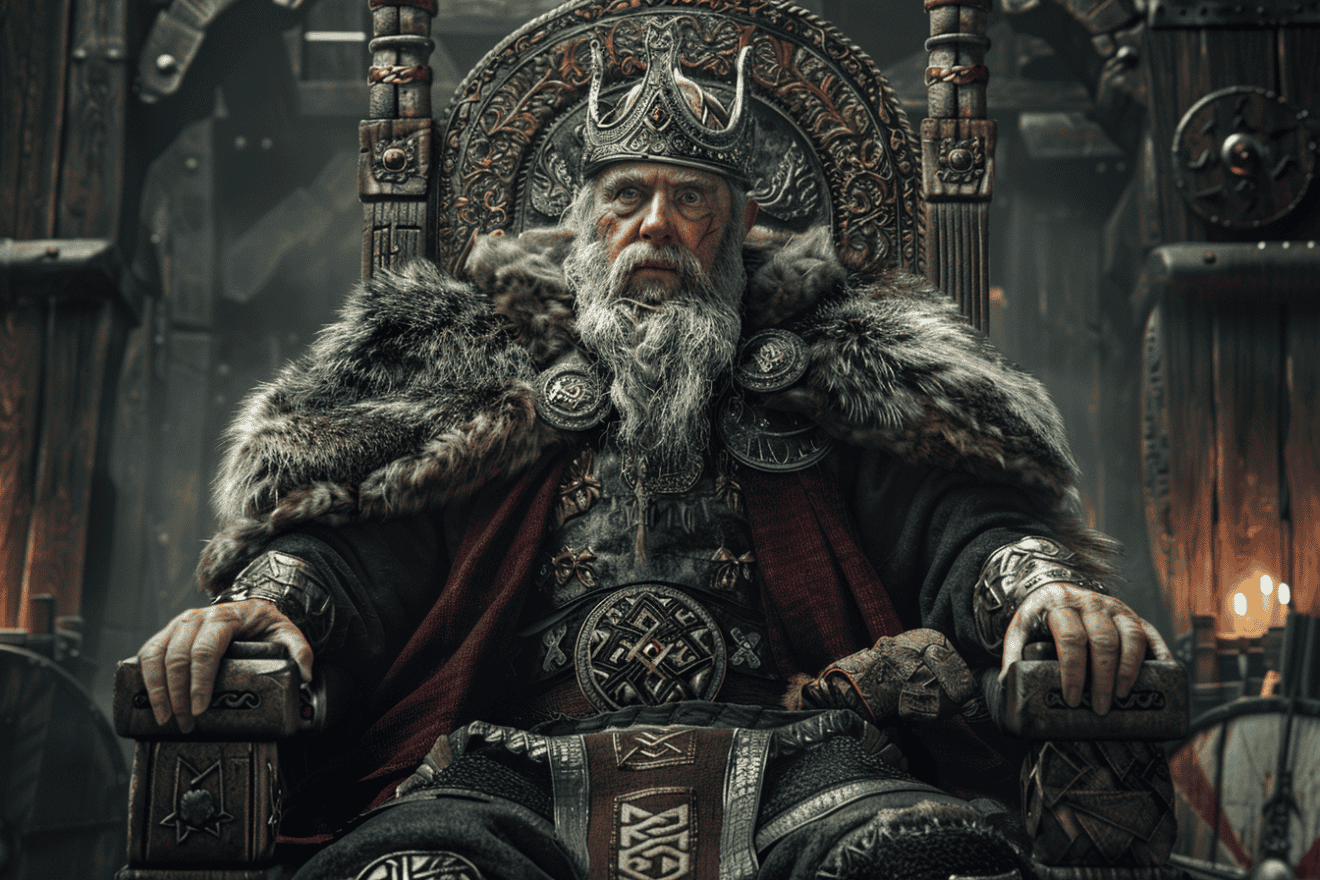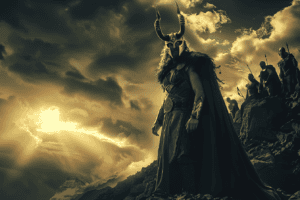Gorm the Old, a pivotal figure in Danish history, forged an enduring legacy as the first to call himself King of Denmark.
Significantly, his bones, initially discovered in 1978 under Jelling Church and printed in 3D in 2017, revealed a ‘bird’s beak’ growth on his neck.
This mysterious physical characteristic sparks curiosity about the man behind the throne. As we explore his life and reign, we discover a complex individual who united Denmark, introduced Christianity, and solidified his power through strategic marriage.
Early Life and Ancestry

Gorm the Old, the enigmatic Viking king of Denmark, grew up in a time of turmoil, his early life shrouded in mystery, with his ancestry tracing back to the legendary Skioldungs, a powerful dynasty of Scandinavian rulers.
There’s no clear information on his birth date, but it’s believed to be before 900 AD. He’s reported to be the son of semi-legendary Danish king Harthacnut, who seized power in the early 10th century, deposing the young king Sigtrygg Gnupasson.
This dynastic connection suggests that Gorm came from a line of powerful Danish leaders. His early years, however, remain largely unknown, with few contemporary sources providing substantial details about his childhood or youth.
Gorm’s rise to power is linked to the Jelling dynasty, which established itself in Jutland, a prominent region of Denmark. His marriage to Queen Thyra further solidified his position as a powerful ruler, commemorated by the Jelling stones that bore their names.
These early steps of his life laid the foundation for his later reign, where he’d establish Jelling as a significant seat of power.
Uniting Denmark and Legacy

The establishment of Jelling as a prominent center of power marked the beginning of a unified Denmark, with the Jelling stones serving as evidence to Gorm’s monumental role in shaping the nation’s future.
As the ruler of Denmark from approximately 936 to 958, Gorm expanded his territories through military campaigns and political engagements outside of his kingdom.
His achievements, including the construction of a significant burial mound in Jelling, are a testament to his powerful leadership and vision for unification.
The Jelling stones, carved with runic inscriptions, serve as a national symbol of Denmark, commemorating both Gorm and his wife Thyra.
Gorm’s legacy extends beyond his military and political accomplishments. He introduced Christianity to Denmark, and his son Harald Bluetooth officially converted the country to Christianity. This significant religious shift not only impacted Denmark but also facilitated cultural and religious exchange with other parts of Europe.
Gorm’s influence on Denmark’s symbolic heritage continues to be felt, solidifying his place as an essential figure in Denmark’s history.
Marriage to Thyra

Around 930, Thyra, a woman of noble birth, became Gorm’s queen, bringing a sense of stability and legitimacy to his rule. This strategic marriage bolstered Gorm’s position as the Viking King of Denmark, solidifying his claim to the throne.
Thyra’s noble lineage and connections likely played a significant role in Gorm’s decision to marry her. As queen, Thyra proved to be a valuable partner, supporting Gorm’s efforts to unify Denmark and strengthen its defenses.
Together, they had several children, including Harald Bluetooth, who would go on to become a prominent figure in Danish history. Thyra’s influence extended beyond the royal family, as she was known for her piety and charitable works.
Her marriage to Gorm lasted for many years, providing a sense of continuity and stability during a tumultuous period in Danish history. Throughout their reign, Thyra remained a loyal and supportive partner, playing an essential role in Gorm’s success as a ruler.
Burial and Reburial

Thyra’s passing marked the beginning of a significant shift in Gorm’s life, as he turned his attention to ensuring a fitting legacy, including a grand burial that would reflect his status as a powerful Viking king.
Gorm the Old’s initial burial took place in a chamber inside the North Mound at Jelling. This mound, now empty, held his remains, along with few artifacts, including a silver cup. The stone slab that sealed his tomb bore the inscription, ‘King Gorm erected this symbol to the honor of the memory of Thyra his wife, Denmark’s Adornment.’
Later, after his son Harald Bluetooth accepted Christianity, Gorm’s body was reburied within a wooden church at Jelling, built specifically for this purpose. This action by Harald signified a significant shift in Denmark’s religious landscape as Christianity spread throughout the kingdom.
Archaeological excavations in the 1970s uncovered remains believed to be Gorm’s, corroborating this reburial. Subsequently, these remains were studied and then reburied in the Jelling Church. This sequence of events highlights the complexity of Gorm’s final journey, reflecting the spiritual evolution of Denmark during his reign.
Physical Characteristics

Reconstructing the appearance of Viking-age rulers like Gorm the Old remains a challenging task, as artifacts provide limited clues about their physical attributes.
Historians rely on fragmented descriptions from medieval sources, such as the 12th-century chronicle of Saxo Grammaticus, to piece together a physical portrait of the king.
According to Saxo, Gorm was a sturdy and powerful man, with a solid build and a commanding presence. His facial features are less clear, although some accounts suggest he’d a prominent nose and piercing eyes.
Gorm’s appearance was likely influenced by his Viking heritage, with a strong physique honed from years of raiding and battle. His hair and beard may have been long and braided, as was the custom among Viking warriors. While these descriptions provide some insight, they’re incomplete and open to interpretation.
Ultimately, the exact physical characteristics of Gorm the Old remain a subject of speculation, leaving historians to fill in the gaps with informed guesswork. Despite these limitations, a rough outline of the king’s appearance emerges, suggesting a formidable leader who inspired both respect and intimidation.
Impact on Christianity

One significant consequence of Gorm’s reign was his opposition to Christianity, which had begun to make inroads into Denmark during the 9th century.
As a staunch pagan, Gorm saw the spread of Christianity as a threat to traditional Danish culture and values. He actively worked to suppress Christian influence, persecuting Christian missionaries and converts alike.
This led to tensions with neighboring Christian kingdoms, particularly the Frankish Empire, which had been actively promoting Christianity in the region.
Gorm’s anti-Christian stance also had significant implications for Denmark’s internal politics. He consolidated power by aligning himself with pagan chieftains and nobles, who shared his suspicions of Christianity.
This move helped to solidify his position as a strong and decisive leader, but it also limited Denmark’s engagement with the wider European community, which was increasingly dominated by Christian powers.
Despite his efforts, Christianity continued to spread in Denmark, and his son, Harald Bluetooth, would eventually adopt the religion and promote its spread throughout the kingdom.










Add Comment